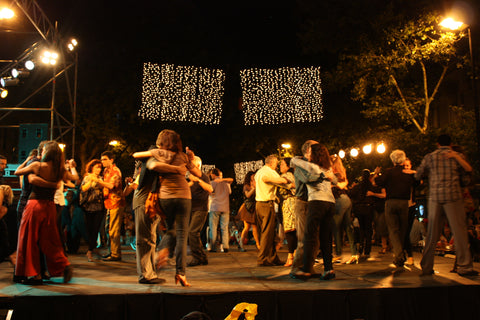Autumn and Tango in Buenos Aires.
by Rebecca T on June 06, 2019 Comments (0)
(Photo Credit and Copyright Rebecca Travaglia 2013)
The city is in the grip of autumn with winter nipping at its heels. The trees are either bare or holding onto the last of their fluttering yellow and green leaves. The only pops of colour come from the orange trees that are found in various barrios lining the sides of the streets. Grey merges into grey as the concrete skyline blends into the moody skies that are accompanying this season. However, this is one of the best times that travelling the city with a soundtrack of tango just makes sense. You can feel the sadness and lament of the lyrics reflected in the puddled cobblestone streets, and sense glints of hope and warmth that lie hidden behind the closed and shuttered doors and windows. Strains of tango music creep under doors and down stairways, enticing you in from the sadness of the streets into a celebration of dance. And a malbec or two.
Porteños (local Buenos Aires residents), from what I can tell, are creatures of warmth and go into hibenation at the first sign of the artic wind and a cloudy sky. They rug up warm and reluctantly head outdoors if they have to, bustling through the narrow streets with head down, usually to make it to their nearest cafe for a piping hot coffee. But head to a milonga, and you are greeted with a different type of porteño. Away from the cold wind and with the warmth of a tango abrazo (embrace) , the spark of the people returns.
Tango is a myriad of sentiments all mixed into one. It has the grit of the street and the beauty of love. It has the darkness of night mixed with the light of hope. It has the sentiment of loneliness whilst danced in an embrace of connection. The music can have the forlorn lament of sadness with the melodic embelishments of desires and dreams. It comes from the streets where this juxtaposition of worlds exists. Simply walk only a few blocks within the central city to pass from the gritty streets of San Telmo, the grandeur of Avenida de Mayo and into the parisian opulence of Recoleta.
The great tango writers took inspiration from the streets and from love, for their lyrics and melodies. A great song to take you through this season is Rosa de Otoño or Autumn Rose. Written in 1923, it is a Vals (or waltz) that was made famous by Carlos Gardel (the golden boy of tango). A love song, it expresses his love for a girl/the city/tango (it never really is explicit although we can assume it is love for a woman) and that without her, he will become sick. Despite all that he suffers, he remains ever hopeful and that is reflected through the melody that weaves its way through the vals.
So if you are out on this overcast autumn day, why not add Rosa de Otoño to your playlist for a beautiful soundtrack as you walk the streets of Buenos Aires.









